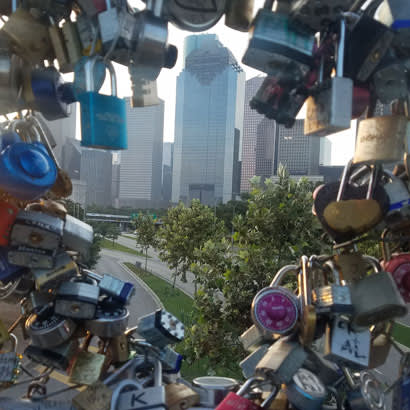
Pictured left: A view of downtown Houston, Texas, through locks on the fence of a pedestrian bridge that connects the Allen Parkway Village housing complex with Buffalo Bayou Park. Photo courtesy of Juan Antonio Sorto.
What does the guilty verdict of three white Georgia men for the murder of Ahmaud Arbery mean for communities of color in the way we use parks and trails?
There has been plenty of coverage about the justice that was served for the murder of Ahmaud Arbery, a Black man who was running in a Georgia subdivision when he was murdered by three white men, who were all since found guilty. Yet, most of the coverage fails to include the parallels that exist between low-income communities of color and the usage of urban placemaking — the planning and usage of public space (parks and trails).
In April 2020, during the height of the COVID-19 pandemic, I started a running streak, which I’ve continued as I train for the 2022 Houston Marathon in January. I mostly train in my own neighborhood, a low-income community in East Houston that is made up of a majority of African American and Hispanic households. While there are plenty of running publications that have highlighted running streaks from a personal success story, my experience has highlighted the difficulties of maintaining a running streak for people residing in communities of color.
For over a year, I have learned to navigate my community’s 7-mile trail, which includes navigating stray animals, illegal dumping, camps from people experiencing homelessness, abandoned homes, unpaved roads, lack of sidewalks, all reminiscences of Hurricane Harvey, and one of largest active landfills in the United States.
While justice was served in the case of the murder of Ahmaud Arbery, this country has a real opportunity to utilize the passage of the $1 trillion infrastructure bill to address social justice from the usage of public space.
For people of color and runners like myself, there exists a disparity between the way low-income and affluent communities use neighborhood parks and trails. For example, many people who live in low-income communities are afraid to access the trails based on the setbacks that I highlighted earlier. This means that when parks and trails are built, they must be followed with the proper programming and safety protocols, such as the installation of lights, police call boxes, trashcans and restrooms. My personal experience as a marathoner has shown me how these amenities are readily available in affluent communities, even though low-income communities have pleaded with government entities for the same type of resources.
The trails and parks need to be inclusive to migrant communities, as well, who have their own languages and cultures. In Houston, which has a population that is 45 percent Hispanic, few parks have signs posted in Spanish. I argue that the inability of parks to create signs in the language of their communities hurts the community and the organizations that maintain these parks. In addition, parks should be built beyond the required American with Disabilities Act. Serving as a guide for athletes with disabilities, I have seen firsthand how runners and cyclists struggle to share the trails, to the point where the trails can become a hazard.
In addition, the parks and trails should be welcoming to women and youth, which means adding tools that they can feel safe to access. While Houston has made bold steps towards creating trails that are accessible to everyone, it does not mean that communities of color feel safe to navigate them. The issues of design and implementation of parks and trails are complex. However, I would argue that a solution is for organizations to start working closely with communities of color and using different communication tools, such as block walking, social media, personal interviews and community meetings to gather feedback.
This also presents an opportunity for organizations to implement DEIA (diversity, equity, inclusion and access) policies and initiatives. It should be noted that Arbery was murdered in a residential neighborhood, which adheres to private development. Much of the funding that organizations and government entities receive for the construction and maintenance of parks and trails comes from philanthropic and private entities. Therefore, it is imperative that the community, government entities and the private market work closely in making parks and trails inclusive for communities of color.
While so much attention has been given to the way Ahmaud Arbery was murdered and the justice he received, it is time to start thinking about the way government entities and organizations apply policy and funding towards the way communities of color have access to parks and trails.
Juan Antonio Sorto is a first-generation college graduate from El Salvador and a doctoral candidate at Texas Southern University's School of Urban Planning and Environmental Justice. He is a marathoner, ultra-marathoner, triathlete and a guide for Achilles International Houston Chapter.

